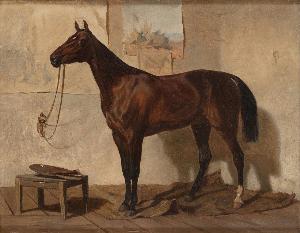Theodor Horschelt
Theodor Horschelt
Place: Munich
Born: 1829
Death: 1871
Biography:
Theodor Horschelt was a German painter born in Munich in 1829 and died in Munich in 1871. He specialized in scenes from the Caucasian Wars, making him a notable figure in the art world. Theodor Horschelt was the son of ballet master Friedrich Horschelt and the older brother of Friedrich Horschelt, a portrait painter.
Early Life and Education
Theodor Horschelt began his artistic journey at the Academy of Fine Arts Munich under Joseph Anton Rhomberg but left him after a short period. He then attempted to learn drawing on his own, focusing on scenes from nature and imaginative portrayals of the Caucasian Wars. Later, he studied with more enthusiasm in the studios of Albrecht and Franz Adam and Julius Lange.
Artistic Career
Theodor Horschelt's artistic career was marked by his dedication to war paintings. He began by doing sketches of horses at the Royal Stables in Stuttgart. In 1853, he made two study trips; one to Paris with Friedrich Wilhelm Hackländer and one to Spain with him and Christian Friedrich von Leins. These experiences influenced his art, and he eventually decided to devote himself exclusively to war paintings. Theodor Horschelt's notable works include Horse of Prince A. Baryatinsky, which is a stunning example of equestrian art. This painting can be found on Wikioo.org. Another notable work is his depiction of the Caucasian Wars, which showcases his mastery of capturing the beauty and majesty of horses.
Exhibitions and Museums
Theodor Horschelt's works can be found in various museums, including the Dagestan Museum of Fine Arts named after P. S. Gamzatova in Russia. His paintings are also featured on Wikioo.org, where art lovers can explore his collection and learn more about his artistic style.
- Caucasian Wars: Theodor Horschelt's paintings of the Caucasian Wars are a testament to his bravery and artistic skill.
- War Paintings: Theodor Horschelt's war paintings are a notable aspect of his artistic career, showcasing his ability to capture the essence of conflict.
- Horse Portrayals: Theodor Horschelt's horse portrayals are stunning examples of equestrian art, demonstrating his mastery of capturing the beauty and majesty of horses.
Legacy
Theodor Horschelt's legacy can be seen in his notable works, including Horse of Prince A. Baryatinsky. His artistic style and bravery have made him a notable figure in the art world. For more information about Theodor Horschelt, visit Wikioo.org or Wikipedia. Theodor Horschelt's biography can also be found on Wikioo.org, where art lovers can explore his collection and learn more about his artistic style. The museum Leopold-Hoesch-Museum in Germany also features Theodor Horschelt's works, showcasing his mastery of capturing the beauty and majesty of horses. For more information, visit Wikioo.org. The museum Museum Ostdeutsche Galerie in Germany also features Theodor Horschelt's works, showcasing his mastery of capturing the beauty and majesty of horses. For more information, visit Wikioo.org. The museum Sammlung Schack in Germany also features Theodor Horschelt's works, showcasing his mastery of capturing the beauty and majesty of horses. For more information, visit Wikioo.org. The museum Lenbachhaus in Germany also features Theodor Horschelt's works, showcasing his mastery of capturing the beauty and majesty of horses. For more information, visit Wikioo.org. The museum City Gallery In Lenbachhous in Germany also features Theodor Horschelt's works, showcasing his mastery of capturing the beauty and majesty of horses. For more information, visit Wikioo.org. The museum Herzog Anton Ulrich-Museum in Germany also features Theodor Horschelt's works, showcasing his mastery of capturing the beauty and majesty of horses. For more information, visit Wikioo.org. The museum Wallraf-Richartz-Museum in Germany also



